formerly eScholarship Editions


|
|
|
|
Your search for
'Renaissance History' in subject
found 20 book(s). | Modify Search | Displaying 1 - 20 of 20 book(s) | |
| 1. | 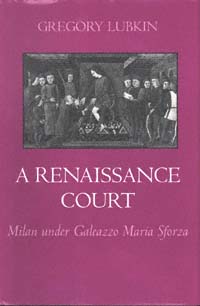 | Title: A Renaissance court: Milan under Galeazzo Maria Sforza Author: Lubkin, Gregory Published: University of California Press, 1994 Subjects: History | Renaissance History Publisher's Description: Ambitious, extravagant, progressive, and sexually notorious, Galeazzo Maria Sforza inherited the ducal throne of Milan in 1466, at the age of twenty-two. Although his reign ended tragically only ten years later, the young prince's court was a dynamic community where arts, policy making, and the panoply of state were integrated with the rhythms and preoccupations of daily life. Gregory Lubkin explores this vital but overlooked center of power, allowing the members of the Milanese court to speak for themselves and showing how dramatically Milan and its ruler exemplified the political, cultural, religious, and economic aspirations of Renaissance Italy. [brief] Similar Items |
| 2. | 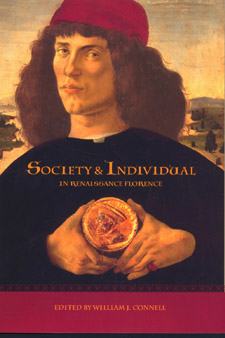 | Title: Society and individual in Renaissance Florence Author: Connell, William J Published: University of California Press, 2002 Subjects: History | Renaissance History | European History Publisher's Description: Renaissance Florence has often been described as the birthplace of modern individualism, as reflected in the individual genius of its great artists, scholars, and statesmen. The historical research of recent decades has instead shown that Florentines during the Renaissance remained enmeshed in relationships of family, neighborhood, guild, patronage, and religion that, from a twenty-first-century perspective, greatly limited the scope of individual thought and action. The sixteen essays in this volume expand the groundbreaking work of Gene Brucker, the historian in recent decades who has been most responsible for the discovery and exploration of these pre-modern qualities of the Florentine Renaissance. Exploring new approaches to the social world of Florentines during this fascinating era, the essays are arranged in three groups. The first deals with the exceptionally resilient and homogenous Florentine merchant elite, the true protagonist of much of Florentine history. The second considers Florentine religion and Florence's turbulent relations with the Church. The last group of essays looks at criminals, expatriates, and other outsiders to Florentine society. [brief] Similar Items |
| 3. | 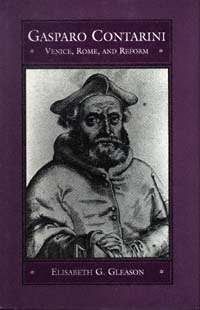 | Title: Gasparo Contarini: Venice, Rome, and reform Author: Gleason, Elisabeth G Published: University of California Press, 1993 Subjects: History | Religion | Renaissance History | European History | Christianity Publisher's Description: Gasparo Contarini (1483-1542) was a major protagonist in the Counter-Reformation of the sixteenth century. A worldly Venetian patrician, he later became an ascetic advocate of Church reform and, as a Catholic cardinal, was sent to the important Colloquy of Regensburg. He failed in his mission to bring about an agreement between Lutherans and Catholics; nevertheless, his life and thought, as well as his friendships with the most vocal proponents of concord, peace, and toleration, make him an impressive and significant historical figure.In the first biography of Contarini since 1885, Elisabeth Gleason greatly broadens our understanding of the man and his times. As a result, scholars and students will come to see Cardinal Gasparo Contarini as a reminder of alternative concepts of authority and liberty in both church and state. [brief] Similar Items |
| 4. | 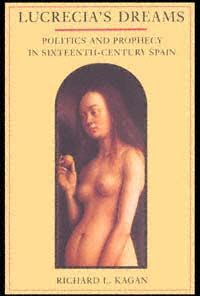 | Title: Lucrecia's dreams: politics and prophecy in sixteenth-century Spain Author: Kagan, Richard L 1943- Published: University of California Press, 1990 Subjects: History | Renaissance History | Women's Studies | Gender Studies Publisher's Description: Branded by the Spanish Inquisition as an "evil dreamer," a "notorious mother of prophets," the teenager Lucrecia de León had hundreds of bleak but richly imaginative dreams of Spain's future that became the stuff of political controversy and scandal. Based upon surviving transcripts of her dreams and on the voluminous records of her trial before the Inquisition, Lucrecia's Dreams traces the complex personal and political ramifications of Lucrecia's prophetic career. This hitherto unexamined episode in Spanish history sheds new light on the history of women as well as on the history of dream interpretation.Charlatan or clairvoyant, sinner or saint, Lucrecia was transformed by her dreams into a cause celébre , the rebellious counterpart to that other extraordinary woman of Golden Age Spain, St. Theresa of Jesus. Her supporters viewed her as a divinely inspired seer who exposed the personal and political shortcomings of Philip II of Spain. In examining the relation of dreams and prophecy to politics, Richard Kagan pays particular attention to the activities of the streetcorner prophets and female seers who formed the political underworld of sixteenth-century Spain. [brief] Similar Items |
| 5. | 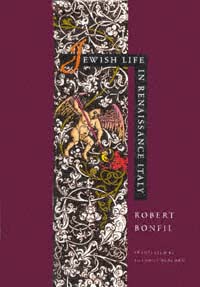 | Title: Jewish life in renaissance Italy Author: Bonfil, Roberto Published: University of California Press, 1994 Subjects: Jewish Studies | Renaissance History | European History Publisher's Description: With this heady exploration of time and space, rumors and silence, colors, tastes, and ideas, Robert Bonfil recreates the richness of Jewish life in Renaissance Italy. He also forces us to rethink conventional interpretations of the period, which feature terms like "assimilation" and "acculturation." Questioning the Italians' presumed capacity for tolerance and civility, he points out that Jews were frequently uprooted and persecuted, and where stable communities did grow up, it was because the hostility of the Christian population had somehow been overcome.After the ghetto was imposed in Venice, Rome, and other Italian cities, Jewish settlement became more concentrated. Bonfil claims that the ghetto experience did more to intensify Jewish self-perception in early modern Europe than the supposed acculturation of the Renaissance. He shows how, paradoxically, ghetto living opened and transformed Jewish culture, hastening secularization and modernization.Bonfil's detailed picture reveals in the Italian Jews a sensitivity and self-awareness that took into account every aspect of the larger society. His inside view of a culture flourishing under stress enables us to understand how identity is perceived through constant interplay - on whatever terms - with the Other. [brief] Similar Items |
| 6. |  | Title: A buccaneer's atlas: Basil Ringrose's South Sea waggoner: a sea atlas and sailing directions of the Pacific coast of the Americas, 1682 Author: Ringrose, Basil d. 1686 Published: University of California Press, 1992 Subjects: History | Renaissance History | European History | Geography Publisher's Description: On July 29, 1681, a band of English buccaneers that had been terrorizing Spanish possessions on the west coast of the Americas captured a Spanish ship, from which they obtained a derrotero , or book of charts and sailing directions. When they arrived back in England, the Spanish ambassador demanded that the buccaneers be brought to trial. The derrotero was ordered to be brought to King Charles II, who apparently appreciated its great intelligence value. The buccaneers were acquitted, to the chagrin of the king of Spain, who had the English ambassador expelled from the court at Madrid on a seemingly trumped-up charge.The derrotero was subsequently translated, and one of the buccaneers, Basil Ringrose, added a text to the compilation and information to the Spanish charts. The resulting atlas, consisting of 106 pages of charts and 106 pages of text, is published in full for the first time in this volume. Covering the coast from California to Tierra del Fuego, the Galapagos, and Juan Fernandes, Basil Ringrose's south sea waggoner is a rich source of geographical information, with observations on navigational, physical, biological, and cultural features as well as on ethnography, customs, and folklore.After almost exactly three hundred years, this secret atlas is now made available to libraries and individuals. The editors have provided an extensive introduction on historical, geographical, and navigational aspects of the atlas, as well as annotations to the charts and text, and they have plotted the coverage of the charts on modern map bases. [brief] Similar Items |
| 7. | 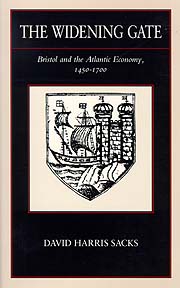 | Title: The widening gate: Bristol and the Atlantic economy, 1450-1700 Author: Sacks, David Harris 1942- Published: University of California Press, 1991 Subjects: History | Renaissance History | European History | United States History Similar Items |
| 8. | 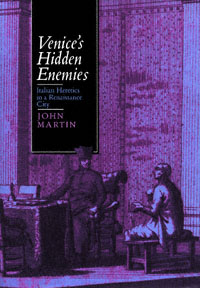 | Title: Venice's hidden enemies: Italian heretics in a Renaissance city Author: Martin, John Jeffries Published: University of California Press, 1993 Subjects: History | European History | Christianity | Renaissance History Publisher's Description: How could early modern Venice, a city renowned for its political freedom and social harmony, also have become a center of religious dissent and inquisitorial repression? To answer this question, John Martin develops an innovative approach that deftly connects social and cultural history. The result is a profoundly important contribution to Renaissance and Reformation studies.Martin offers a vivid re-creation of the social and cultural worlds of the Venetian heretics - those men and women who articulated their hopes for religious and political reform and whose ideologies ranged from evangelical to anabaptist and even millenarian positions. In exploring the connections between religious beliefs and social experience, he weaves a rich tapestry of Renaissance urban life that is sure to intrigue all those involved in anthropological, religious, and historical studies - students and scholars alike. [brief] Similar Items |
| 9. | 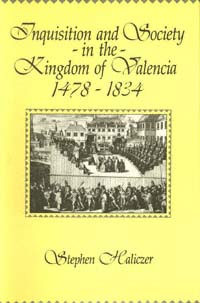 | Title: Inquisition and society in the kingdom of Valencia, 1478-1834 Author: Haliczer, Stephen 1942- Published: University of California Press, 1990 Subjects: History | European History | Medieval History | Renaissance History Similar Items |
| 10. | 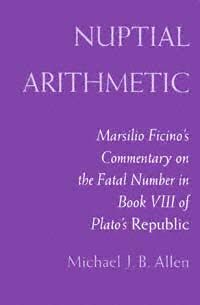 | Title: Nuptial arithmetic: Marsilio Ficino's commentary on the fatal number in Book VIII of Plato's Republic Author: Allen, Michael J. B Published: University of California Press, 1994 Subjects: Classics | Philosophy | Medieval Studies | Renaissance History Publisher's Description: The latest of Michael Allen's distinguished studies of the Renaissance Neoplatonist, Marsilio Ficino (1433-1499), presents a difficult, fascinating text. Late in his career, Ficino wrote a commentary on the intractable passage in Book VIII of Plato's Republic that concerns the mysterious geometric or "fatal" number. He was thus the first modern interpreter of this famous passage, and Allen is the first in our era to translate and elucidate his remarkable commentary.Allen's critical translation of Ficino's analysis of the fatal number passage shows how it develops philosophical, psychological, numerological, astrological, and prophetic themes that had a particular resonance at the end of the fifteenth century. [brief] Similar Items |
| 11. | 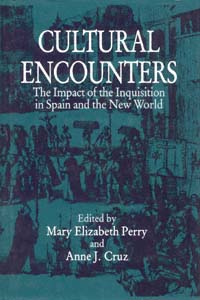 | Title: Cultural encounters: the impact of the Inquisition in Spain and the New World Author: Perry, Mary Elizabeth 1937- Published: University of California Press, 1991 Subjects: History | Anthropology | European History | Religion | Renaissance History Publisher's Description: More than just an expression of religious authority or an instrument of social control, the Inquisition was an arena where cultures met and clashed on both shores of the Atlantic. This pioneering volume examines how cultural identities were maintained despite oppression.Persecuted groups were able to survive the Inquisition by means of diverse strategies - whether Christianized Jews in Spain preserving their experiences in literature, or native American folk healers practicing medical care. These investigations of social resistance and cultural persistence will reinforce the cultural significance of the Inquisition. [brief] Similar Items |
| 12. | 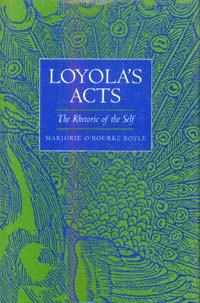 | Title: Loyola's acts: the rhetoric of the self Author: Boyle, Marjorie O'Rourke 1943- Published: University of California Press, 1997 Subjects: Literature | Renaissance History | Christianity | Rhetoric | Art History | Medieval History Publisher's Description: This revisionist view of Ignatius Loyola argues that his "autobiography" - until now taken to be a literal, documentary account - is in reality a work of rhetoric, a moral narrative that exploits the techniques of fiction. In radically reinterpreting this canonical text, our main source of information about the founder of the largest and most powerful religious order in Roman Catholicism, Boyle paints a vivid picture of Loyola's world. She surveys rhetorical and artistic theory, religious iconography, everyday custom, and an astonishing array of scenes and subjects: from curiosity, to codes of honor, to the holy places of Spain, to the significance of apparitions and flying serpents.Written in the tradition of Renaissance studies on individualism, Loyola's Acts engages current interest in autobiography and in the history of private life. The book also provides a powerful heuristic for interpreting a wide range of texts of the Christian tradition. Finally, this secular treatment of a canonized saint provides revealing insights into how a prestigious sixteenth-century figure like Loyola understood himself. [brief] Similar Items |
| 13. | 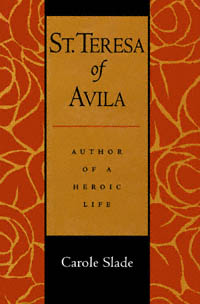 | Title: St. Teresa of Avila: author of a heroic life Author: Slade, Carole Published: University of California Press, 1995 Subjects: Religion | Christianity | Women's Studies | Autobiographies and Biographies | Renaissance History Publisher's Description: With few exceptions, representations of Renaissance women were created by men. The Spanish saint, Teresa of Avila (1515-1582), who chose to represent herself, was one of those exceptions. What prompted her to write Book of Her Life, Interior Castle , and other works? What does the self-portrait of this sixteenth-century nun, mystic, and founder of convents reveal about its author, the church, state, and role of women? St. Teresa of Avila , an innovative analysis of Teresa's autobiographical writings, explores these and many other questions. Bringing to bear a knowledge of Inquisition studies, theory of autobiography, scriptural hermeneutics, and hagiography, Carole Slade defines Teresa's writings as a project of self-interpretation undertaken mainly as the result of the perceived, later realized, threat of an accusation of heresy. Being female and of paternal Jewish ancestry, Teresa was vulnerable to such a charge.Teresa's writing project presented her with serious difficulties. Judicial confession, her prescribed genre, presumed the writer's guilt, while the subordinate female script precluded a defense against the suspicion that her mystical experiences came from the devil. Through careful textual analysis, Slade demonstrates that Teresa exploited the nuances of numerous genres - hagiography, New World chronicle, mystical theological treatise, and early novel - to create an innocent textual persona and depict herself in heroic terms.A signal contribution to our understanding of Teresa's rhetorical and literary talent and life circumstances, this book will engage readers across a broad range of disciplines. [brief] Similar Items |
| 14. | 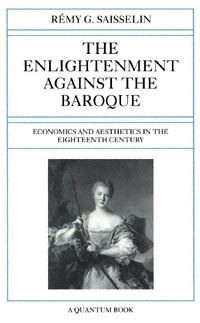 | Title: The Enlightenment against the Baroque: economics and aesthetics in the eighteenth century Author: Saisselin, Rémy G. (Rémy Gilbert) 1925- Published: University of California Press, 1992 Subjects: History | Economics and Business | Popular Culture | Art | Renaissance History Publisher's Description: How do seemingly disparate arenas of Enlightenment philosophy, economic theories, boudoir etiquette, literary styles, and artistic modes coincide in the late eighteenth century? In this poetic essay on the evolution of the idea of luxury and art, Rémy Saisselin uses precise, witty examples to describe the development of our modern taste, ultimately the successor of the more spiritual and grand baroque goût . His analysis both illuminates and distinguishes between eighteenth-century and modern varieties of conspicuous consumption.This persuasive discourse depicts the rise of luxe as an escape from ennui and shows how, for the first time in European history, a large class of wealthy, leisured people emerged to make art, luxury, and the avoidance of boredom its preoccupation. Saisselin provides an original and lucid picture of the first phases in the emergence of a specifically bourgeois taste. [brief] Similar Items |
| 15. | 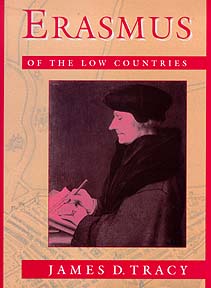 | Title: Erasmus of the Low Countries Author: Tracy, James D Published: University of California Press, 1997 Subjects: History | European History | Autobiographies and Biographies | Renaissance History Publisher's Description: Few historical figures have been more important in modeling the ideal of impartial critical scholarship than Erasmus of Rotterdam (1469-1536). Yet his critical scholarship, though beholden to no one, was not dispassionate. James Tracy shows how Erasmus the scholar sought through his writings to promote the moral and religious renewal of Christian society.Tracy finds the genesis of the humanist's notion of a "Christian republic" of pious and learned individuals in his "Burgundian," or Low Countries, roots. Erasmus's vision of reform, Tracy argues, sprung from a humanist tradition focusing on the importance of teaching ( doctrina ), a tradition from which Erasmus departed in his optimism about human nature and his deep suspicion of the powers that be. Amid the storms of Reformation controversy, he pruned back the "dissimulation" by which he had thought to convey different meanings to different readers, yet in the end he could not control the way his words were read. If Erasmus's scholarly ideal carries an enduring fascination, so too does his dilemma as a man of circumspection who would also be a reformer. [brief] Similar Items |
| 16. | 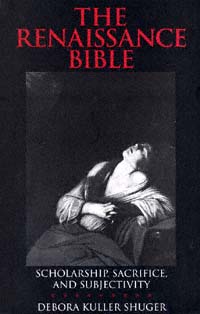 | Title: The Renaissance Bible: scholarship, sacrifice, and subjectivity Author: Shuger, Debora K 1953- Published: University of California Press, 1994 Subjects: Literature | Religion | Literary Theory and Criticism | Renaissance History | Christianity | Renaissance Literature Publisher's Description: This is the first book on the Renaissance Bible by an Anglo-American scholar in nearly fifty years. Not confined to a history of exegesis, it is instead a study of Renaissance culture - a culture whose central text was the Bible. Shuger explores, among other topics, the links between late medieval Christology and early modern subjectivity; religious eroticism and the origins of the sexualized body; the transformation of humanist philology into comparative religion; and the representation of daughter-sacrifice and female erotic desire. [brief] Similar Items |
| 17. | 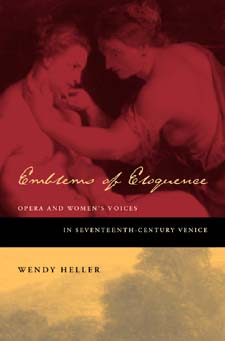 | Title: Emblems of eloquence: opera and women's voices in seventeenth-century Venice Author: Heller, Wendy Beth Published: University of California Press, 2004 Subjects: Music | European Studies | Opera | Classical Music | Women's Studies | Classical Literature and Language | Renaissance History Publisher's Description: Opera developed during a time when the position of women - their rights and freedoms, their virtues and vices, and even the most basic substance of their sexuality - was constantly debated. Many of these controversies manifested themselves in the representation of the historical and mythological women whose voices were heard on the Venetian operatic stage. Drawing upon a complex web of early modern sources and ancient texts, this engaging study is the first comprehensive treatment of women, gender, and sexuality in seventeenth-century opera. Wendy Heller explores the operatic manifestations of female chastity, power, transvestism, androgyny, and desire, showing how the emerging genre was shaped by and infused with the Republic's taste for the erotic and its ambivalent attitudes toward women and sexuality. Heller begins by examining contemporary Venetian writings about gender and sexuality that influenced the development of female vocality in opera. The Venetian reception and transformation of ancient texts - by Ovid, Virgil, Tacitus, and Diodorus Siculus - form the background for her penetrating analyses of the musical and dramatic representation of five extraordinary women as presented in operas by Claudio Monteverdi, Francesco Cavalli, and their successors in Venice: Dido, queen of Carthage (Cavalli); Octavia, wife of Nero (Monteverdi); the nymph Callisto (Cavalli); Queen Semiramis of Assyria (Pietro Andrea Ziani); and Messalina, wife of Claudius (Carlo Pallavicino). [brief] Similar Items |
| 18. | 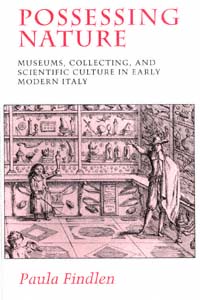 | Title: Possessing nature: museums, collecting, and scientific culture in early modern Italy Author: Findlen, Paula Published: University of California Press, 1994 Subjects: History | History and Philosophy of Science | European History | Renaissance History Publisher's Description: In 1500 few Europeans regarded nature as a subject worthy of inquiry. Yet fifty years later the first museums of natural history had appeared in Italy, dedicated to the marvels of nature. Italian patricians, their curiosity fueled by new voyages of exploration and the humanist rediscovery of nature, created vast collections as a means of knowing the world and used this knowledge to their greater glory.Drawing on extensive archives of visitors' books, letters, travel journals, memoirs, and pleas for patronage, Paula Findlen reconstructs the lost social world of Renaissance and Baroque museums. She follows the new study of natural history as it moved out of the universities and into sixteenth- and seventeenth-century scientific societies, religious orders, and princely courts. Findlen argues convincingly that natural history as a discipline blurred the border between the ancients and the moderns, between collecting in order to recover ancient wisdom and the development of new textual and experimental scholarship. Her vivid account reveals how the scientific revolution grew from the constant mediation between the old forms of knowledge and the new. [brief] Similar Items |
| 19. | 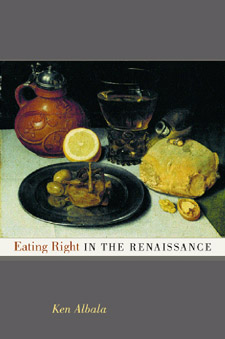 | Title: Eating right in the Renaissance Author: Albala, Ken 1964- Published: University of California Press, 2002 Subjects: Food and Cooking | Renaissance History | History of Science | History of Food Publisher's Description: Eating right has been an obsession for longer than we think. Renaissance Europe had its own flourishing tradition of dietary advice. Then, as now, an industry of experts churned out diet books for an eager and concerned public. Providing a cornucopia of information on food and an intriguing account of the differences between the nutritional logic of the past and our own time, this inviting book examines the wide-ranging dietary literature of the Renaissance. Ken Albala ultimately reveals the working of the Renaissance mind from a unique perspective: we come to understand a people through their ideas on food. Eating Right in the Renaissance takes us through an array of historical sources in a narrative that is witty and spiced with fascinating details. Why did early Renaissance writers recommend the herbs parsley, arugula, anise, and mint to fortify sexual prowess? Why was there such a strong outcry against melons and cucumbers, even though people continued to eat them in large quantities? Why was wine considered a necessary nutrient? As he explores these and other questions, Albala explains the history behind Renaissance dietary theories; the connections among food, exercise, and sex; the changing relationship between medicine and cuisine; and much more. Whereas modern nutritionists may promise a slimmer waistline, more stamina, or freedom from disease, Renaissance food writers had entirely different ideas about the value of eating right. As he uncovers these ideas from the past, Ken Albala puts our own dietary obsessions in an entirely new light in this elegantly written and often surprising new chapter on the history of food. [brief] Similar Items |
| 20. | 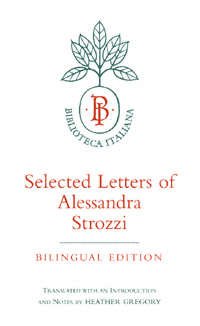 | Title: Selected letters of Alessandra Strozzi Author: Macinghi Strozzi, Alessandra 1407-1471 Published: University of California Press, 1997 Subjects: History | Renaissance History | Women's Studies | European Studies | Literature in Translation | Autobiography | European History | Letters Publisher's Description: The letters of Alessandra Strozzi provide a vivid and spirited portrayal of life in fifteenth-century Florence. Among the richest autobiographical materials to survive from the Italian Renaissance, the letters reveal a woman who fought stubbornly to preserve her family's property and position in adverse circumstances, and who was an acute observer of Medicean society. Her letters speak of political and social status, of the concept of honor, and of the harshness of life, including the plague and the loss of children. They are also a guide to Alessandra's inner life over a period of twenty-three years, revealing the pain and sorrow, and, more rarely, the joy and triumph, with which she responded to the events unfolding around her.This edition includes translations, in full or in part, of 35 of the 73 extant letters. The selections carry forward the story of Alessandra's life and illustrate the range of attitudes, concerns, and activities which were characteristic of their author. [brief] Similar Items |